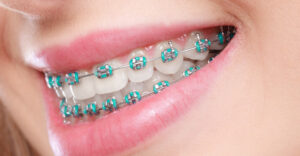At Okuda Orthodontics, we believe that a healthy smile starts early. Interceptive orthodontic treatment is a proactive approach that helps guide a child’s facial and jaw growth, ensuring proper alignment of teeth before more serious issues arise. Many parents are surprised to learn that early orthodontic evaluation is recommended by the American Association of Orthodontists at age seven, even before all the permanent teeth have erupted. This early intervention can significantly improve dental development, reduce the need for invasive treatments later, and set the foundation for a lifetime of excellent oral health.
What Is Interceptive Orthodontic Treatment?
Interceptive orthodontics is a two-phase orthodontic treatment designed to address dental concerns while a child’s mouth is still developing. Unlike traditional braces, which are typically placed after all the permanent teeth have come in, interceptive treatment begins during childhood when baby teeth and permanent teeth coexist.
This treatment aims to prevent severe orthodontic issues by guiding jaw growth, ensuring enough space for permanent teeth to erupt properly, and correcting early bite problems. By addressing these concerns at a young age, orthodontists can help children avoid complex treatments, extractions, or surgical interventions in the future.
Phase One: Early Treatment and Jaw Development
The first phase of interceptive orthodontic treatment typically begins between ages six and ten, while a child still has primary teeth and their first permanent molars are emerging. During this phase, an orthodontist evaluates the child’s dental structure, facial and jaw growth, and potential orthodontic concerns. Common early interventions include:
- Palatal expanders to create more space for erupting permanent teeth.
- Orthodontic appliances to correct bite alignment issues such as overbites, underbites, or crossbites.
- Space maintainers to ensure that there is adequate room for future teeth to come in properly.
This phase does not always require braces but instead focuses on setting the stage for a smooth transition to permanent teeth.
Phase Two: Full Orthodontic Treatment
Once a child has enough permanent teeth, the second phase of treatment begins. This typically involves braces or clear aligners, refining the teeth’s alignment and ensuring the bite is fully corrected. Because Phase One has already addressed jaw and spacing concerns, Phase Two is often shorter and more efficient.
The Benefits of Early Orthodontic Treatment
Early orthodontic treatment offers numerous advantages, making it a valuable investment in a child’s oral health and confidence. By addressing orthodontic concerns in childhood, interceptive treatment can:
1. Guide Proper Jaw Growth and Development
The early years of jaw growth play a crucial role in overall oral health. Interceptive orthodontics helps to guide the upper and lower jaw into proper alignment, reducing the likelihood of severe bite issues that could require surgery or extractions later in life. This proactive approach ensures that there is sufficient space left for all the permanent teeth to erupt in a healthy position.
2. Reduce the Risk of Dental Disease
Crowded or crooked teeth can make it difficult to maintain proper oral hygiene, leading to tooth decay, gum disease, and periodontal disease. Early treatment helps prevent these issues by properly aligning the teeth, making brushing and flossing more effective. A child’s dental health is closely linked to their overall well-being, and interceptive orthodontic treatment can significantly improve oral health by reducing plaque buildup and bacteria accumulation.
3. Prevent Severe Bite and Alignment Issues
Bite disorders such as overbites, underbites, and crossbites can cause problems with chewing, speaking, and even breathing. Early interceptive treatment allows orthodontists to correct bite misalignment before it affects a child’s jaw function and overall facial structure. Addressing these issues early can also prevent jaw pain and unnecessary wear on tooth enamel.
4. Minimize the Need for Future Treatment
By correcting potential problems early, interceptive orthodontics can reduce the need for extensive treatments in adolescence or adulthood. Many children who undergo early intervention require a shorter duration of braces in their teenage years because significant issues were already corrected in Phase One. This can save both time and money, making orthodontic treatment more efficient in the long run.
5. Improve Speech Development and Chewing Function
Misaligned teeth and jaw structure can affect a child’s ability to speak clearly and chew food properly. Interceptive orthodontic treatment helps ensure that teeth are positioned correctly for optimal speech and eating functions. This not only benefits oral health but also overall nutrition and communication skills.
6. Boost Self-Esteem and Confidence
A child’s smile plays a significant role in their self-esteem and social interactions. Early orthodontic treatment helps prevent dental irregularities that may cause a child to feel self-conscious about their teeth. A healthy smile improves confidence, making children feel better about their appearance and encouraging them to express themselves freely.
Does My Child Need Interceptive Orthodontics?
Not every child requires early orthodontic treatment, but an orthodontic evaluation at age seven allows orthodontists to determine if intervention is necessary. Some indicators that a child might benefit from interceptive orthodontics include:
- Protruding front teeth, which may be at risk for injury.
- Early loss of baby teeth, affecting the space for permanent teeth to erupt.
- Crowded or widely spaced teeth that could indicate improper jaw growth.
- Bite misalignment issues, such as overbites, underbites, or crossbites.
- Mouth breathing or tongue thrusting habits, which can influence jaw development.
- Difficulty chewing or biting due to improper teeth alignment.
Treatment Options in Interceptive Orthodontics
There are several orthodontic appliances used in early treatment, depending on the child’s needs. Some of the most common include:
- Palatal expanders – Used to widen the upper jaw, creating more space for permanent molars and preventing crowding.
- Space maintainers – Preserve the space left by missing baby teeth, ensuring proper eruption of adult teeth.
- Partial braces – Sometimes used to correct minor alignment issues before all the permanent teeth erupt.
- Habit appliances – Help children stop thumb sucking or tongue thrusting, which can affect facial and jaw growth.
Investing in a Healthy Smile with Early Orthodontic Treatment
Parents often wonder if early orthodontic care is necessary, but interceptive orthodontic treatment is a proactive approach that can save time, money, and discomfort in the long run. By identifying and addressing potential orthodontic problems early, Okuda Orthodontics helps children achieve healthy, well-aligned smiles that last a lifetime.
If you are wondering whether your child is a candidate for early interceptive treatment, our team is here to help. Schedule a consultation at Okuda Orthodontics in Henderson, NV, or call us at (702) 737-5500. Let’s give your child the best start for a lifetime of healthy smiles.




